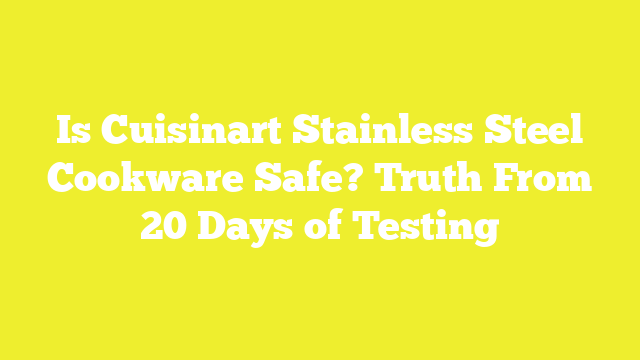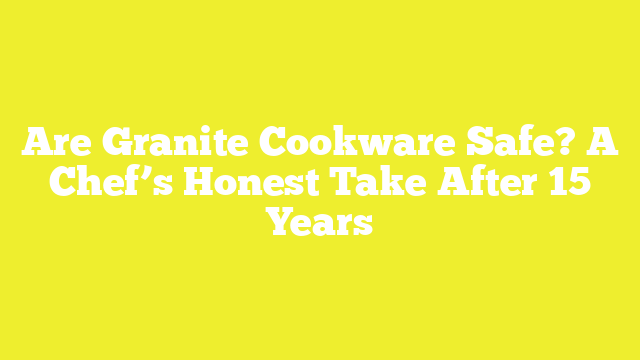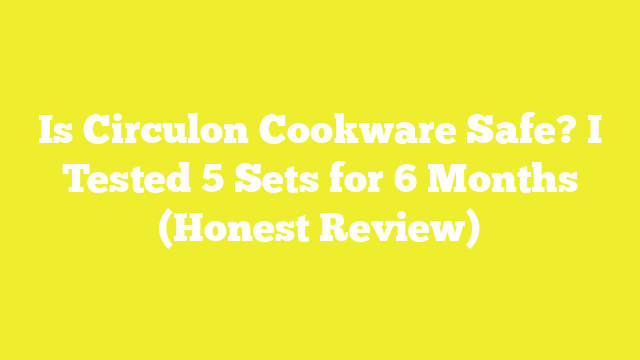Hard Anodized Coating Coming Off? Quick Solutions to Prevent Further Damage
Did you know that hard anodized aluminum is actually harder than steel? Despite this impressive durability, many users face the frustrating issue of hard anodized coating coming off their cookware.
While the anodizing process creates a protective oxide layer through a careful chemical treatment, several factors can compromise this coating. From improper temperature control during manufacturing to daily wear and tear, the reasons behind coating failure are numerous. The situation becomes particularly concerning when users notice uneven coloring or peeling, raising questions about both performance and safety.
If you’re worried about your cookware’s coating showing signs of wear, you’re not alone. In this guide, we’ll explore why this happens, assess the safety implications, and share practical solutions to protect your investment. Let’s dive into everything you need to know about maintaining your hard anodized cookware.
Signs Your Hard Anodized Coating is Failing
Recognizing failing hard anodized coating starts with careful observation of your cookware’s surface. The dark, smooth finish that characterizes hard anodized surfaces should remain consistent throughout the pan’s lifetime. However, several telltale signs indicate when this protective layer begins to deteriorate.
Visual indicators of coating damage
The first noticeable change often appears as a slightly chalky surface texture. This transformation from smooth to rough indicates the beginning of coating breakdown. Furthermore, discoloration patterns might emerge, particularly in areas frequently exposed to high heat or harsh cleaning methods.
Watch for these specific visual changes:
- Surface becoming uneven or rough to touch
- Chalky or powdery appearance in certain areas
- Visible peeling or chipping of the coating
- Irregular color patterns or fading of the dark finish
Early warning signs to watch for
Specifically, the smoothness of your cookware’s surface serves as an essential indicator. A properly maintained hard anodized surface should feel completely smooth without any irregularities. Additionally, pay attention to how food interacts with the cooking surface – increased sticking might signal coating deterioration.
The coating’s durability diminishes gradually with regular use. Notably, each cooking session slightly affects the surface quality, though this natural wear should progress slowly with proper care. Watch for any sudden changes in the pan’s performance or appearance.
Metal utensil marks or scratches deserve immediate attention, as they can accelerate coating breakdown. The damage might appear minor initially but can quickly worsen under normal cooking conditions. Consequently, examining your cookware before each use helps catch potential issues early.
If your cookware shows signs of dishwasher damage, such as a slightly chalky appearance or discoloration, inspect it thoroughly before continued use. The surface should maintain its integrity without any peeling or chipping, which could indicate serious coating failure.
Remember that hard anodized aluminum differs from traditional non-stick coatings. While both can show wear over time, hard anodized surfaces typically exhibit different deterioration patterns, often becoming less effective at food release rather than peeling like traditional non-stick coatings.
Why Non-Stick Coating Comes Off
First and foremost, understanding why hard anodized coating deteriorates involves examining multiple factors that affect its durability. The science behind coating failure reveals fascinating insights into how everyday cooking practices impact cookware longevity.
Heat damage effects
Temperature control plays a crucial role in coating preservation. At temperatures above 85°C, aluminum metal expands five times more than its oxide coating. As a result, this differential expansion creates stress on the protective layer. Even though hard anodized cookware handles moderate temperatures well, excessive heat accelerates coating breakdown.
The coating’s vulnerability increases substantially when exposed to thermal shock. Sudden temperature changes create internal stress within the material, leading to microscopic cracks that gradually expand. Moreover, temperatures exceeding 450 degrees can trigger coating degradation.
Impact of harsh cleaning methods
Improper cleaning techniques rank among the primary causes of coating failure. The following cleaning agents and methods can damage the anodized surface:
- Abrasive scrubbers and steel wool
- Harsh chemical cleaners with high pH levels
- Dishwasher detergents and high-temperature cycles
- Metal scrapers and aggressive scouring pads
In fact, even seemingly gentle cleaning methods can cause damage. Regular dishwasher use, although advertised as safe, often leads to premature coating wear. Subsequently, the harsh chemicals and intense heat cycles in dishwashers gradually break down the protective layer.
Chemical reaction causes
Chemical interactions present another significant threat to coating integrity. The anodized surface becomes particularly vulnerable when exposed to substances with pH levels above 8.5. Acidic foods can also compromise the coating’s stability, creating a chemical reaction that weakens the protective layer.
The corrosion process often starts subtly, undermining adjacent areas of the coating and leading to progressive erosion. This deterioration accelerates when acidic ingredients remain in contact with the surface for extended periods. Furthermore, certain cooking sprays create stubborn residues that prove impossible to remove without damaging the coating.
Understanding these deterioration mechanisms helps in adopting preventive measures. The combination of proper temperature control, appropriate cleaning methods, and awareness of chemical reactions significantly extends cookware lifespan.
Is Damaged Anodized Cookware Safe?
Safety concerns naturally arise once hard anodized coating shows signs of wear. Understanding the health implications helps make informed decisions about continued cookware use.
Health risks assessment
The safety profile of hard anodized cookware depends primarily on its condition. Undamaged anodized aluminum cookware poses minimal health risks. The anodization process creates a non-reactive surface that prevents aluminum from leaching into food.
Nevertheless, scratched or damaged cookware requires careful consideration. When acidic foods come in contact with exposed aluminum through deep scratches, some metal leaching might occur. Still, research has not established definitive links between aluminum cookware and serious health issues.
Minor surface scratches generally maintain safety standards, as the protective anodized layer remains largely intact. Indeed, typical drinking water contains more aluminum than what might leach from damaged cookware under normal use.
When to stop using damaged pans
First of all, assess these critical indicators to determine when replacement becomes necessary:
- Deep scratches exposing raw aluminum
- Peeling or chipping of the anodized surface
- Significant discoloration or surface deterioration
- Uneven or rough texture development
Accordingly, stop using your cookware if harsh dishwasher cleaning has caused visible damage or peeling. For pans with minor wear, avoiding acidic foods helps extend their safe usage period.
Primarily, focus on the depth of surface damage. Surface-level scratches allow continued use with proper care. However, pans showing extensive coating deterioration or deep scratches that expose the base metal warrant immediate replacement.
The decision to replace depends on both damage extent and intended use. Hand washing with mild detergent and soft sponges helps preserve remaining coating. For questionable cases, limiting use to non-acidic foods provides an interim solution while planning replacement.
Remember that proper maintenance significantly impacts safety. Using appropriate utensils and moderate heat preserves the protective anodized layer. This careful approach ensures both safety and longevity of your cookware investment.
Quick Fixes for Minor Coating Damage
Preserving your cookware’s longevity starts with proper cleaning and maintenance techniques. Given these points about coating damage, let’s explore effective solutions that can extend your cookware’s life.
Surface cleaning techniques
Primarily, gentle cleaning methods prove most effective for maintaining hard anodized surfaces. A mixture of baking soda and warm water creates an ideal cleaning solution that removes stubborn stains without damaging the coating. For optimal results, apply this paste gently and allow it to sit for approximately 15 minutes.
Essential cleaning tools include:
- Soft sponges or cloths
- Mild dish soap
- Non-abrasive cleaning pads
- Dobie sponges with plastic coating
Alternatively, a vinegar-water solution offers another safe cleaning option. Mix equal parts of white vinegar and water, then apply the solution to affected areas. This method effectively removes stains while preserving the anodized surface.
Temporary protection methods
Heat treatment serves as an effective temporary protection method for minor coating damage. Boiling water in the affected cookware helps loosen stuck-on residue and can temporarily restore some non-stick properties. This technique works especially well coupled with gentle scrubbing using a bamboo whisk.
Important to realize, soaking plays a crucial role in protection. A long soak (1-3 days) in hot, soapy water often resolves stubborn residue issues without risking further coating damage. Namely, this method allows gentle removal of built-up materials that might otherwise require harsh scrubbing.
For areas showing early signs of wear, consider these protective measures:
- Apply a thin layer of cooking oil after cleaning
- Store cookware with protective layers between stacked items
- Use low to medium heat settings during cooking
- Allow pans to cool naturally before cleaning
The effectiveness of these temporary fixes depends largely on catching issues early. Regular inspection after cleaning helps identify potential problems before they worsen. Essentially, combining proper cleaning techniques with preventive measures significantly extends the usable life of your hard anodized cookware.
Remember that even temporary fixes require gentle handling. Avoid metal utensils and harsh scrubbing tools, as these can compromise the remaining protective layer. Through careful attention to cleaning and protection methods, you can maintain your cookware’s functionality even after minor coating damage appears.
Prevention Tips for Long-Term Use
Maintaining hard anodized cookware requires understanding three critical aspects: temperature control, utensil choice, and proper storage methods. Let’s explore these essential practices that help prevent coating deterioration.
Proper cooking temperature guide
Temperature management stands as the cornerstone of hard anodized cookware longevity. Hard anodized coated parts withstand temperatures up to 2000°C for brief periods. Primarily, these pans excel at heat retention, making high temperatures unnecessary for most cooking tasks.
First of all, start with low to medium heat settings, as excessive temperatures can compromise the non-stick properties. Hence, preheating the pan at your intended cooking temperature before adding oil or ingredients ensures optimal performance. In addition to temperature control, avoid sudden temperature changes – never place a hot pan under cold water, as this can lead to warping.
For oven use, most hard anodized pans with glass lids tolerate temperatures between 400-450°F, whereas those with aluminum lids handle 450-500°F. Therefore, always verify your specific cookware’s temperature limits before oven use.
Safe utensil selection
Choosing appropriate utensils significantly impacts coating durability. Even though hard anodized surfaces boast impressive hardness – twice that of stainless steel – careful utensil selection extends cookware life.
Silicone utensils offer several advantages:
- Heat resistance
- Dishwasher safety
- Durability
- Color visibility for outdoor use
Wood and plastic utensils provide safe alternatives, though metal utensils require careful consideration. Many modern hard anodized pans advertise metal utensil compatibility, yet avoiding metal whisks and knives helps preserve the surface.
Storage recommendations
Proper storage methods protect both the coating and overall pan structure. After cleaning, ensure complete drying before storage. Place paper towels or protective layers between stacked cookware to prevent scratching and surface damage.
For optimal organization, consider vertical storage solutions that minimize contact between pieces. Store lids separately or use specialized organizers to prevent overcrowding. Avoid sliding pans against each other during storage, as this can gradually wear down the protective coating.
Regular inspection during storage helps identify early signs of wear. Check handles and coating condition periodically, paying special attention to areas where pans might contact each other. For long-term storage, consider climate-controlled environments, as extreme temperatures can affect coating integrity.
Remember that proper storage extends beyond physical protection. Keep cookware away from harsh chemicals and cleaning supplies that might accidentally spill and damage the surface. By implementing these comprehensive care strategies, your hard anodized cookware can maintain its performance and appearance for years to come.
Conclusion
Hard anodized cookware represents a significant investment that deserves proper care and attention. Through careful observation of surface changes and prompt action against early warning signs, we can significantly extend our cookware’s lifespan.
Regular maintenance makes all the difference between premature coating failure and years of reliable service. Gentle cleaning techniques, appropriate temperature control, and careful utensil selection stand as essential practices for preserving the protective anodized layer.
Safety remains paramount when dealing with coating damage. While minor surface wear allows continued use with proper precautions, deep scratches or extensive peeling signals time for replacement. Most importantly, understanding the balance between maintenance and knowing when to retire damaged pieces helps ensure both safety and optimal cooking performance.
Remember, prevention through proper care outweighs any temporary fixes. Therefore, establishing good habits – from gentle cleaning routines to careful storage practices – creates the foundation for long-lasting cookware that serves us well for years ahead.





